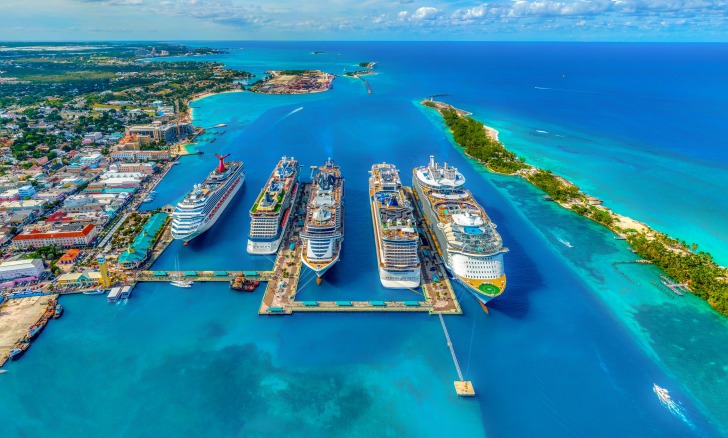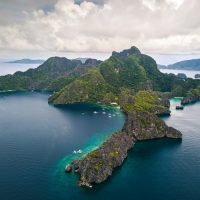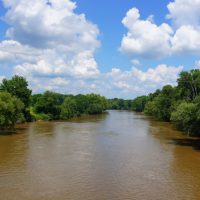The Bahamas are one of the most beautiful and fascinating places in the world.
This grouping of hundreds of islands encompasses the Lucayan Archipelago in the Atlantic Ocean.
The tropical climate and proximity to the water make it a haven for animals of all kinds.
The country has dedicated wildlife protection programs in place to keep these animals safe, and millions of tourists enjoy viewing these creatures every year.
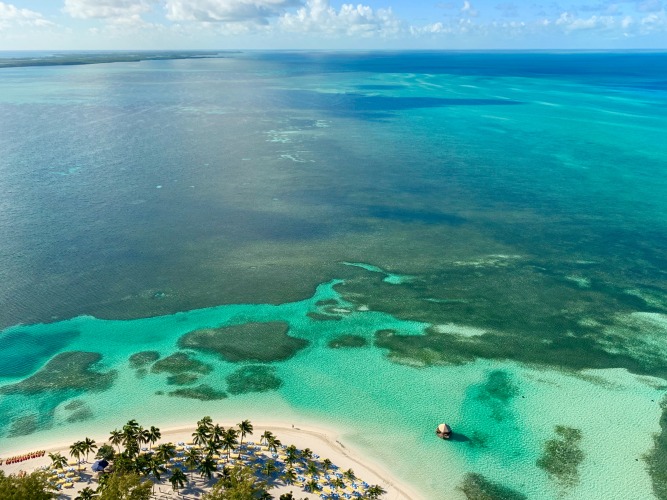
Contents
So… Are There Alligators in The Bahamas?
Simply put, no — there are no crocodilians of any kind in The Bahamas.
Interestingly, however, records show that there used to be.
Explorer records mention alligators in the Bahamas as late as the 1880s and as early as the 1730s.
Most historians think that these reports came from isolated viewings of American alligators traveling from modern-day Florida.
Since the westernmost islands of the Bahamas are only about 50 miles from the Florida coast — and considering that alligators are extremely competent ocean swimmers — it is not out of the realm of possibility that they could have traveled to the islands.
Since alligators are typically solitary creatures, it would also make sense that they would not have come to the Bahamas in significant populations, despite the travel of a few individuals.
Interestingly, archeological research on the islands has shown that there were once crocodilians there — nearly 3,000 years ago in the northern parts of the Bahamas.
The skeletal remains found by paleontologists most closely resemble the modern Cuban crocodile.
While the Bahamas share much of the same wildlife as both Cuba and Hispaniola, the islands no longer have any crocodilians.
Cuba, however, has both American alligators and Cuban crocodiles (as well as spectacled caimans introduced by human intervention).
Several national parks in Haiti and the Dominican Republic support populations of American alligators and saltwater crocodiles.
Alligator Species in The Bahamas
There are no alligator species native to the Bahamas.
However, historical reports of sightings of the American alligator have occurred, and there is evidence that the Cuban crocodile dwelled on the islands around 2,800 years ago.
The American alligator is found throughout much of the American south, but its favorite home is Florida.
More than 2.5 million individuals are found throughout the state, with roughly 200,000 in the Everglades.
These alligators can grow up to 12 feet long and weigh as much as 1,000 pounds.
They have dark green, almost black, scales.
These alligators thrive in freshwater but can handle short-term exposure to saltwater.
They were once critically endangered, but laws enacted in the 1970s made it illegal to hunt or kill them.
Their population numbers have since rebounded.
The Cuban crocodile is today found exclusively in Cuba.
This species is considered endangered and is only found in two wetlands in the country.
Cuban crocodiles are smaller than average but also extremely competent at traveling on land, unlike many other crocodilians.
They are known for being curious and aggressive, which may make them difficult to keep in captivity.
However, they are incredibly intelligent and have even been known to learn basic commands.
Is it Safe to Swim in The Bahamas?
The Bahamas are known for its stunning beaches, which draw millions of tourists every year.
Most of the beaches are highly safe with warm, pleasant water and plenty of shallow areas.
However, as with any other beach, there are potential dangers and swimmers should always practice safety standards.
Here are a few things you should be careful of in the Bahamas.
Rip Tides
Though the waters in the Bahamas are mild and pleasant, the rip tides can be surprisingly strong.
These can develop suddenly and unexpectedly, and even strong swimmers can be caught off guard.
Pay close attention and keep to the marked areas of the beach.
These can be particularly strong on certain beaches, so make sure you get all the facts about the area before visiting a particular beach.
Marine Life
Though the Bahamas are home to many sharks, they rarely make an appearance along the beach.
In fact, there have only been about 32 shark attacks reported since 1749.
So, while it is always good to be vigilant, you’re unlikely to encounter a shark while swimming.
You should be on the lookout for smaller marine life such as jellyfish and lionfish.
Lionfish are not native to the Bahamas, but there are significant populations around the island.
These beautiful fish are an exciting sight but have venomous spines that can cause extreme pain.
Sun
As with any beach, it is vital to be careful with sun exposure.
The Bahamas enjoy the sun throughout the year, but it is easy to become seriously sunburned, even in the water.
Make sure that you use a high SPF sunblock and reapply it regularly.
Take breaks to sit in a shady spot and rehydrate to protect yourself from dehydration or heat exhaustion.
Interesting Alligator Facts in The Bahamas
The fossils showing evidence of crocodilians in the Bahamas were discovered in a sinkhole in 2007.
These fossils were extremely well-preserved thanks to being surrounded by saltwater and almost untouched by oxygen, which causes decomposition.
The remains were dated back to roughly 3,000 years ago — incidentally, around the same time that humans first arrived in the Bahamas.
Because of the conditions of the water around the islands, the crocodiles would have been forced to hunt on land.
This brought them in contact with humans, who probably killed them to avoid becoming prey.
With human populations wiping out crocodile populations thousands of years ago, crocodilians have only sporadically returned to the Bahamas — as chronicled in several European settlers’ logs between the eighteenth and nineteenth centuries.
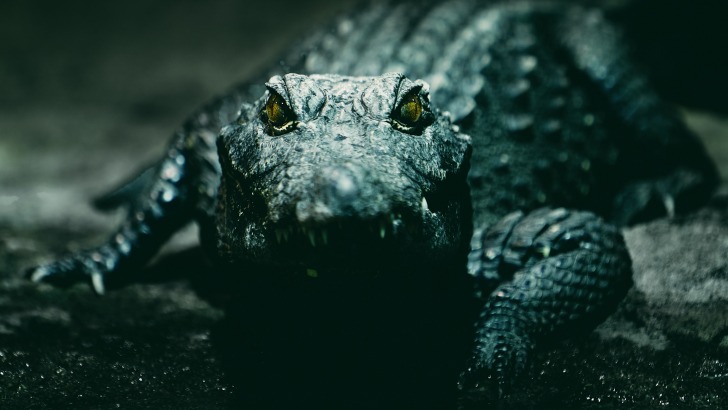
Alligators vs. Crocodiles
Neither alligators nor crocodiles live in the Bahamas, but just across the Straits of Florida is the only place in the world where these species live side by side.
In general, alligators are found across North America and in small populations in China.
Crocodiles can be found throughout the Caribbean, South America, Africa, Southeast Asia, and Australia.
Other differences between alligators and crocodiles are largely physical.
Here are a few other ways you can identify the two species:
Color
Alligators tend to be darker in color.
They may be dark green, deep gray, or almost black.
Crocodiles, on the other hand, are usually light green or even brown.
Size
Both species are large, but crocodiles are usually significantly larger.
While the male American alligator may reach up to 14 feet long and 1,000 pounds, the male Nile crocodile may weigh as much as 1,700 pounds.
However, this isn’t universal among crocodile species.
The Cuban crocodile is smaller, reaching only 11 feet long and about 474 pounds.
Snout
This is the most well-known physical difference between alligators and crocodiles.
Alligators have larger, U-shaped snouts.
Crocodiles have thinner, sharper snouts shaped like a V.
They may also have several teeth protruding when their mouth is closed.
Habitat
Alligators live in freshwater and can only handle short-term exposure to salty environments.
Crocodiles can thrive in either freshwater or saltwater thanks to the special glands they have in their mouths, which filter saline from their bodies.
3 Safety Tips for Swiming in Alligator-infested Waters
Since there are no alligators in the Bahamas, you won’t need to watch out for them while you swim.
But if you are swimming elsewhere where alligators may be present — such as the nearby Florida coast — you may want to keep an eye out.
Here are a few ways to stay safe while swimming in alligator-infested waters.
1. Never Swim Alone
Alligators are unlikely to attack humans unless they feel threatened or mistake them as prey.
They are much more likely to think a solo swimmer is a potential meal than a large group of people.
To reduce the risk of drawing an alligator’s attention, stick to swimming with others.
A group of people splashing and making lots of noise.
2. Swim During The Day
Alligators are nocturnal, so they are most active at dawn and dusk.
To reduce the risk of an alligator encounter, swim in the middle of the day when they are likely to be in their nests.
Never swim at night in areas where alligators are known to live.
3. Avoid Banks And Areas With Dense Vegetation
Alligators tend to prefer staying in shallow waters with muddy water and dense plant matter.
This is where you are most likely to encounter one.
To reduce the risk of meeting an alligator, stick to open water where they are unlikely to feel cornered or threatened.
Summary
Though there have been reports of alligator sightings in the past, no alligators inhabit the Bahamas today.
However, they thrive in abundance less than 60 miles away in the Florida Everglades.
The Bahamas are home to many other diverse reptiles, including snakes, lizards, and turtles.
The Bahamas Safety Overview
READ THE FULL REPORT: The Bahamas Safety Review
Safety Index:
- OVERALL RISK: LOW
- TRANSPORT & TAXIS RISK: LOW
- PICKPOCKETS RISK: MEDIUM
- NATURAL DISASTERS RISK: MEDIUM
- MUGGING RISK: MEDIUM
- TERRORISM RISK: LOW
- SCAMS RISK: MEDIUM
- WOMEN TRAVELERS RISK: LOW
Frequently Asked Questions
What is The Most Dangerous Animal in The Bahamas?
For such a diverse area filled with wildlife, there are not many dangerous animals in The Bahamas.
The islands have no venomous snakes, for example, though you will find boas of several kinds.
These do not usually pose a danger to humans, though it is wise to stay away from them all the same.
The country’s famous Exuma pigs can occasionally be dangerous, as juveniles have been known to attack people.
The Brazilian wandering spider thrives in and around banana plants in the Bahamas and has a venomous bite that can cause cardiac arrest or respiratory failure without emergency medical treatment.
How Far Can Alligators Swim?
Alligators are known for being astonishingly strong swimmers, covering as much as 20 miles per hour.
The southern coast of Florida is roughly 55 miles from the nearest Bahamian islands, making it well within the realm of possibility for an American alligator to swim from the mainland.
What Reptiles Live in The Bahamas?
The Bahamas’ animal population varies widely between the northern and southern islands and the more highly-populated or remote “out” islands.
Across the islands, you may find reptiles almost anywhere.
There are 22 species of lizards native to the Bahamas, most notably iguanas.
Snakes are also common, particularly the brown racer and many types of boas.
At least four species of sea turtles may be seen on the more remote islands, including green sea turtles, loggerheads, hawksbills, and leatherbacks.
